Key takeaways:
- Abstract photography emphasizes emotions and concepts over literal reality, allowing viewers to interpret images personally.
- This style encourages creative exploration and personal growth, pushing photographers to embrace ambiguity and unconventional subjects.
- Techniques such as motion blur and unusual angles can enhance creativity, transforming ordinary scenes into captivating imagery.
- Sharing work in photography forums fosters community engagement, feedback, and provides opportunities for personal development and connection with others.

Understanding abstract photography
Abstract photography is all about capturing emotions and concepts rather than literal representations of reality. I remember a time when I was drawn to the play of light on water. Instead of focusing on the landscape itself, I concentrated on the rippling reflections and colors, which transformed an ordinary scene into something profoundly evocative.
When I first experimented with this style, I often questioned what I was actually trying to express. Can a blurred image convey more than a sharp one? I found that the beauty of abstraction lies in its ambiguity, allowing viewers to project their feelings and interpretations onto the image. Each photograph can become a conversation starter, prompting different reactions from each observer.
For me, abstraction can evoke nostalgia, joy, or even a sense of mystery. I recall capturing a simple shadow cast by a branch against a wall. To others, it might look like a random pattern, but to me, it represented the fleeting moments of nature. Isn’t it fascinating how a single image can spark such diverse thoughts and emotions? Ultimately, that’s the allure of abstract photography: its profound ability to connect us on deeper levels through visual ambiguity.
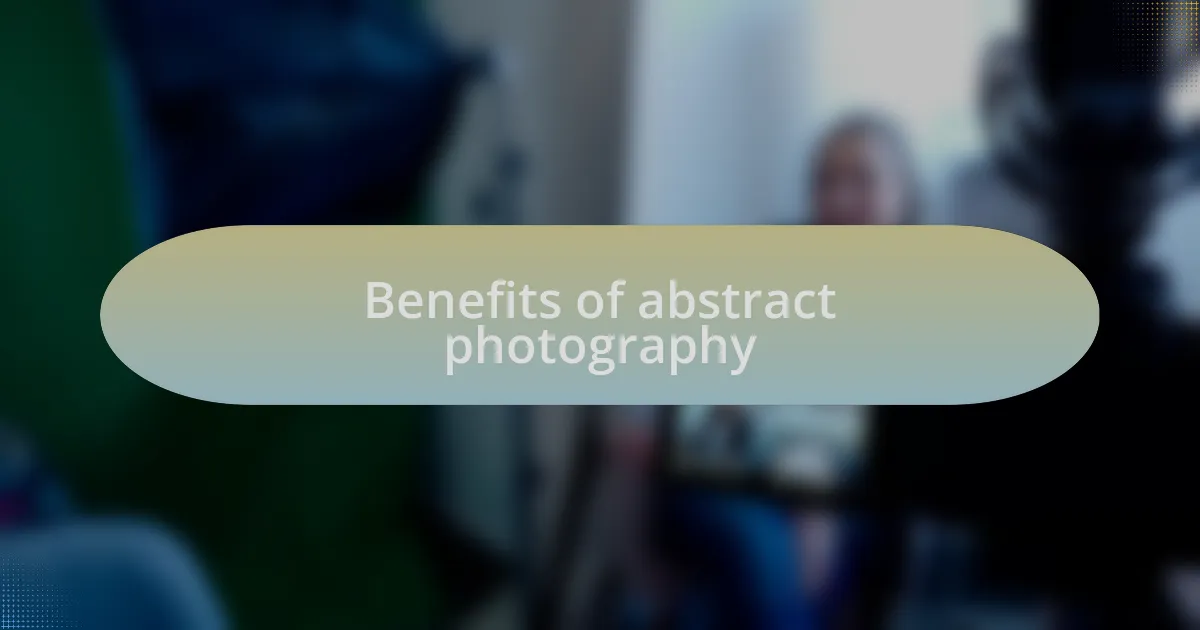
Benefits of abstract photography
Abstract photography offers a unique gateway to unlock creativity. When I began exploring this style, I realized it pushed me to think outside the box, challenging traditional views of composition and subject matter. I remember capturing a weathered concrete wall, where the cracks and peeling paint told a story of time. It made me appreciate the beauty in decay and imperfection, revealing layers of meaning that might go unnoticed in more literal photography.
Moreover, this form of expression can enhance emotional resilience. I’ve noticed that engaging with abstract images often stirs deep feelings within me, allowing for a cathartic experience. There’s something powerful about translating emotions into visual forms; it’s like giving voice to those feelings that are usually hard to articulate. Have you ever felt a wave of calm while gazing at a blurred vision of swirling colors? That’s the magic of abstraction—it invites us to explore our inner worlds.
Another notable benefit is the opportunity for personal growth. Every abstract photo I take teaches me something new about perception and interpretation. I remember a series of shots I took of shadows and light play on a colorful surface. Initially, I was hesitant, but those images taught me to embrace uncertainty and trust my instincts. This journey fosters a sense of adventure in photography—each click of the shutter opens up endless possibilities for connection and understanding. Isn’t that what makes photography so exhilarating?
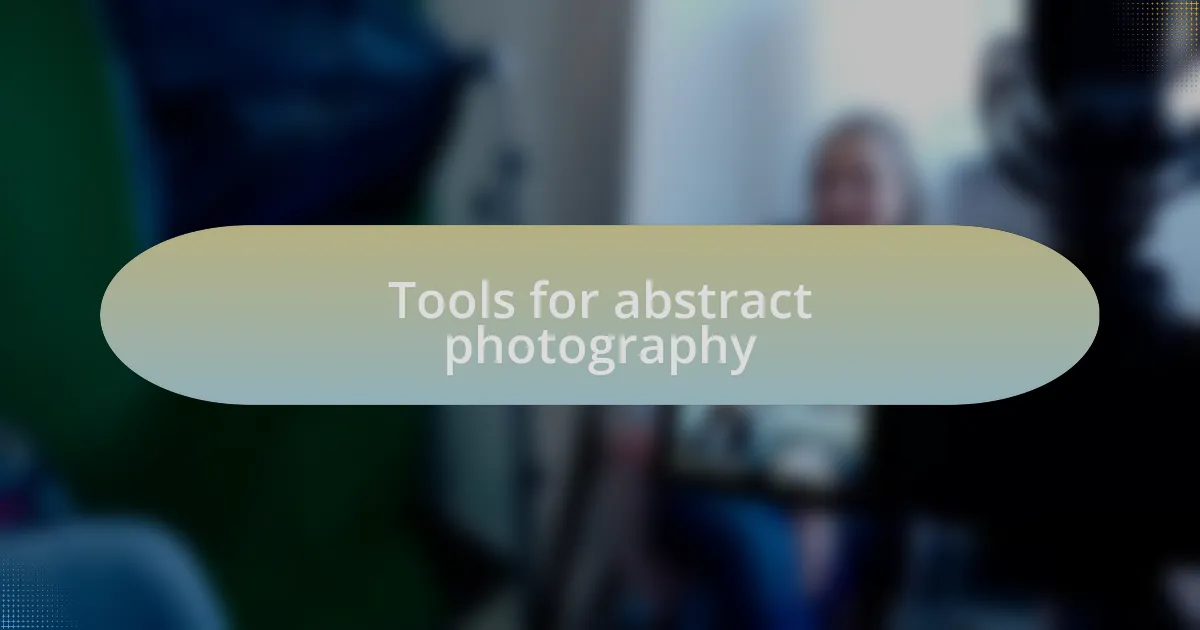
Tools for abstract photography
When diving into abstract photography, the tools you choose can significantly shape your creative expression. I often rely on my DSLR camera for its manual settings, which allow me to play with exposure and focus. Recently, I experimented with a soft-focus lens, transforming ordinary subjects into dreamlike images. It’s fascinating how a simple change in equipment can shift my entire perspective and lead me to unexpected results.
Editing software plays a crucial role in crafting abstract images. I frequently use programs like Lightroom and Photoshop to manipulate colors and shapes, enhancing the surreal quality of my photos. For instance, by adjusting contrast and saturation, I’ve turned mundane street scenes into vibrant compositions that evoke emotions I didn’t anticipate feeling. Have you ever altered an image only to discover a new layer of meaning you hadn’t seen before? That’s the beauty of combining tools—each adjustment can unlock a fresh narrative.
Don’t underestimate the power of everyday objects as tools for abstraction. I often capture reflections in puddles or the interplay of shadows created by simple items on my desk. On one occasion, I used a plastic bottle to create quirky light patterns, producing an image that felt both whimsical and profound. This experience taught me that inspiration is everywhere; sometimes, the best tools are right in front of us, waiting to feed our imagination. What unique objects have you used to spark your creativity lately?
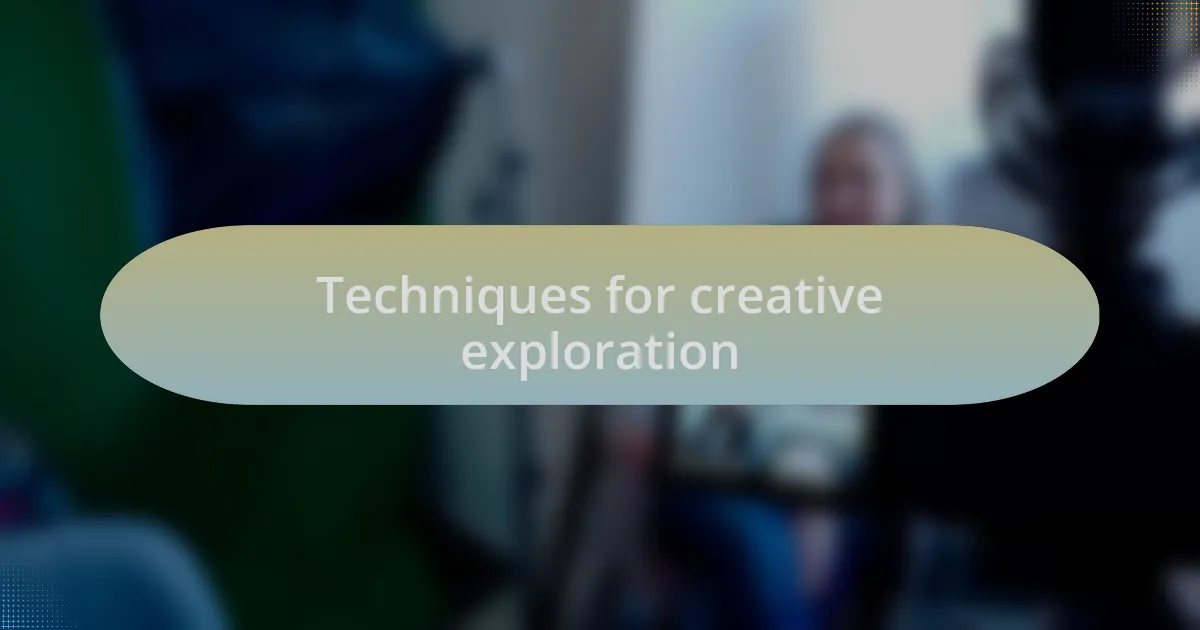
Techniques for creative exploration
Exploring texture and light can dramatically enhance the creativity in abstract photography. I remember one day while shooting in my garden; I focused on the intricate patterns formed by sunlight filtering through leaves. This simple act of observing detail led to a series of images that felt almost alive, capturing a vibrant essence that I hadn’t anticipated. Have you ever noticed how light can morph reality into something extraordinary?
Another technique I often embrace is motion blur. Just last week, I set my camera to a slower shutter speed while capturing a bustling market scene. The resulting image, filled with swirling colors and ghostly figures, created a sense of movement that conveyed the energy of the event. It’s fascinating how allowing the camera to record time can evoke feelings that static images sometimes struggle to convey.
Incorporating unusual angles can yield surprising results too. One of my favorite shots came when I took an overhead view of scattered art supplies on my workspace. The chaos morphed into a stunning abstract composition that sparked my imagination. Have you tried shooting from unexpected perspectives? It’s a wonderful reminder that sometimes, changing your viewpoint can unlock new creative pathways.
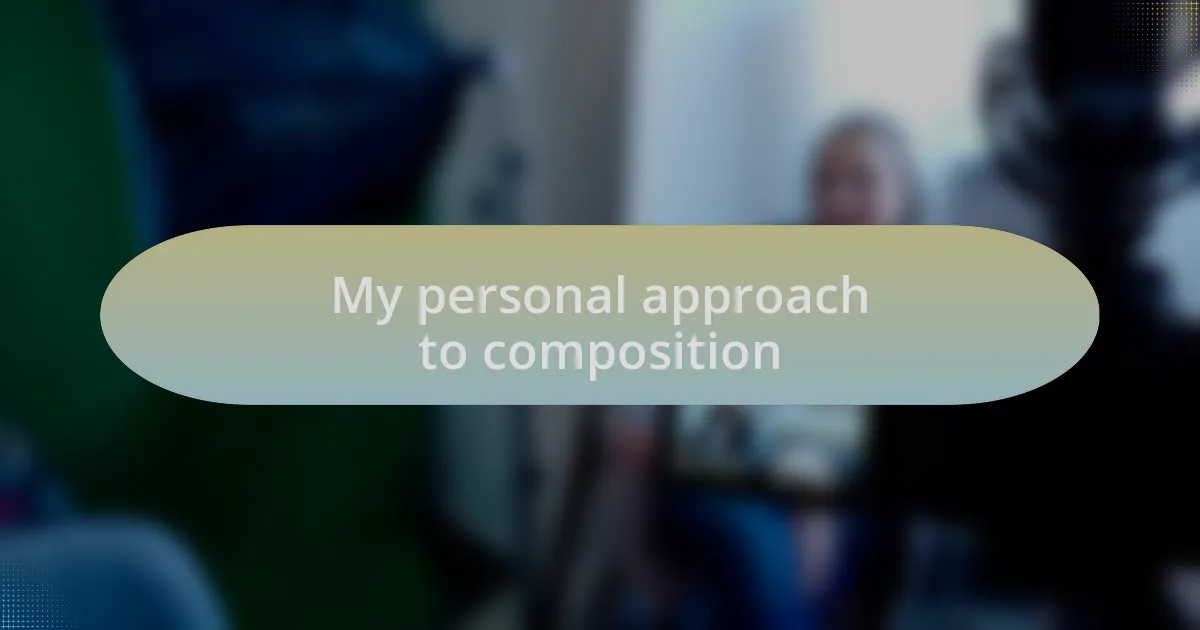
My personal approach to composition
My personal approach to composition often revolves around the concept of simplicity. For instance, while photographing a single flower in a vast field, I deliberately eliminated distractions by zooming in and using a shallow depth of field. This technique effectively drew focus to the delicate petals, transforming a common subject into an intimate piece of art. Have you ever considered how removing clutter can amplify the message of your photograph?
Creating balance within the composition also plays a key role in my work. I remember a landscape shoot where I positioned a lone tree on one side of the frame, allowing the expanse of the sky to dominate the other. This deliberate imbalance created tension, drawing the viewer’s eye and evoking a feeling of isolation. It’s always intriguing to think about how positioning can influence the emotional response to an image, don’t you think?
Lastly, I find layering elements within the frame adds depth and intrigue to my compositions. During a recent urban exploration, I captured a vibrant mural reflected in a rain puddle on the street. Layering the vivid colors of the art with the moody reflections created a rich visual narrative. Have you experimented with layering? It’s a simple yet powerful technique that can transform an ordinary scene into something truly captivating.
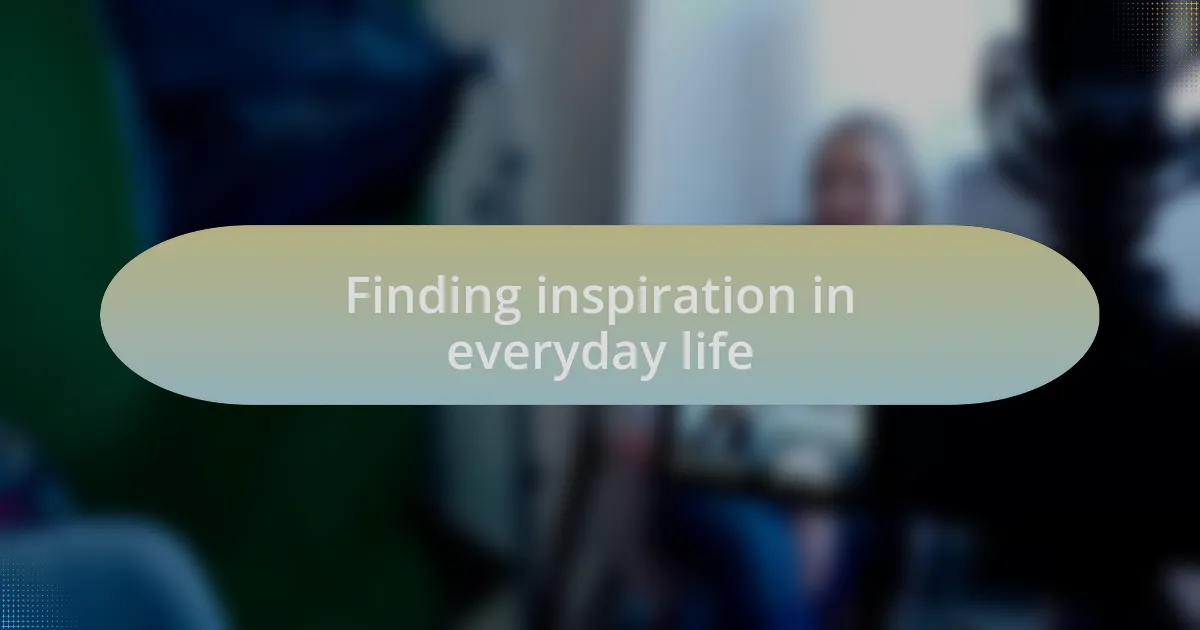
Finding inspiration in everyday life
Finding inspiration in everyday life often starts with shifting my perspective. I remember a day when I was stuck in traffic, feeling frustrated. Instead of letting that frustration take over, I began to notice the play of light on the cars around me. The reflections and shadows created abstract shapes that inspired a series of photographs exploring movement and chaos. Have you ever found beauty in a seemingly mundane moment?
Sometimes, it’s the small details that capture my heart. On a walk through my neighborhood, I discovered a weathered door adorned with peeling paint and rusted hinges. Instead of seeing it as just an old door, I imagined the stories it could tell. Photographing it from different angles allowed me to convey a sense of history and resilience. What details in your surroundings have sparked your creativity lately?
I’ve also learned to embrace serendipity in my daily life. One afternoon, while washing dishes, I noticed the patterns created by soap bubbles dancing in the sunlight. It was unexpected, but it sparked an idea for a project on transience. Capturing those fleeting moments taught me how inspiration can be found in the simplest tasks. Have you ever had a moment like that when a burst of creativity struck from an everyday activity?

Sharing my work in forums
Sharing my work in photography forums has been a game changer for my creative process. I vividly recall the excitement of posting my first abstract piece and the immediate feedback I received. The encouragement from fellow photographers warmed my heart and pushed me to experiment even more. Have you ever felt that thrill of sharing something deeply personal and being met with open arms?
When I upload a new image, I often accompany it with a short story about my thought process behind the shot. This context helps others connect with my work on a deeper level. I remember one post where I shared my struggles in capturing the essence of reflections in puddles after rain. The genuine discussions that followed not only enriched my understanding but also forged new friendships. What opportunities have you found to share your journey and connect with like-minded artists?
Engaging in critique sessions within forums has also profoundly impacted my growth. I still think back to the constructive feedback I received on a series that delved into conceptual themes. At first, I was hesitant to share such vulnerable work, fearing judgment. Instead, the responses I received helped me refine my vision and take bold steps forward. Isn’t it fascinating how sharing your art can unlock new avenues of creativity?